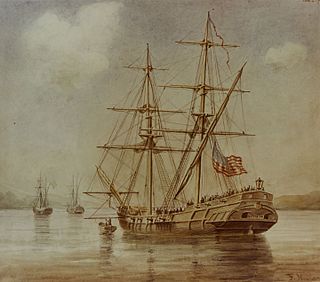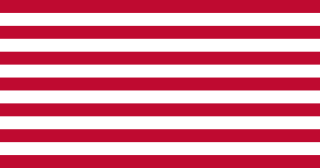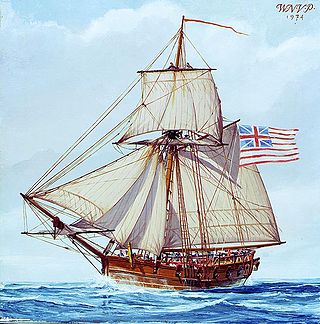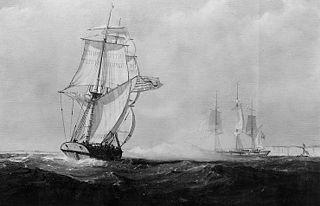
The first USS Lexington of the Thirteen Colonies was a brig purchased in 1776. The Lexington was an 86-foot two-mast wartime sailing ship for the fledgling Continental Navy of the Colonists during the American Revolutionary War (1775–1783).

The Continental Navy was the navy of the Thirteen Colonies during the American Revolutionary War. Founded on October 13, 1775, the fleet developed into a relatively substantial force throughout the Revolutionary War, owing partially to the substantial efforts of the Continental Navy's patrons within the Continental Congress. These Congressional Patrons included the likes of John Adams, who served as the Chairman of the Naval Committee until 1776, when Commodore Esek Hopkins received instruction from the Continental Congress to assume command of the force.
John Young was a captain in the Continental Navy during the American Revolutionary War, commander of the Saratoga which was lost at sea.
Lambert Wickes was a captain in the Continental Navy during the American Revolutionary War.

USS Ranger was a sloop-of-war in the Continental Navy in active service in 1777–1780, the first to bear her name. Built at Portsmouth Naval Shipyard on Badger's Island in Kittery, Maine, she is famed for the one-ship raiding campaign by Captain John Paul Jones, during naval operations of the American Revolutionary War. In six months spent primarily in British waters she captured five prizes, staged a single failed attack on the English mainland at Whitehaven, and caused Royal Navy ships to be dispatched against her in the Irish Sea.

USS Providence was a sloop-of-war in the Continental Navy, originally chartered by the Rhode Island General Assembly as Katy. The ship took part in a number of campaigns during the first half of the American Revolutionary War before being destroyed by her own crew in 1779 to prevent her falling into the hands of the British after the failed Penobscot Expedition.

USS Raleigh was one of thirteen ships that the Continental Congress authorized for the Continental Navy in 1775. Following her capture in 1778, she served in the Royal Navy as HMS Raleigh. The ship is featured on the flag and seal of New Hampshire.
The first Dolphin was a cutter in the Continental Navy.
The first USS Hancock was an armed schooner under the Continental Army during the American Revolutionary War. She was named for patriot and Continental Congress member John Hancock. Congress returned her to her owner in 1777.
The first USS Lee was a schooner under the Continental Army during the American Revolutionary War. She was named for General Charles Lee.

The second Hancock was one of the first 13 frigates of the Continental Navy. A resolution of the Continental Congress of British North America 13 December 1775 authorized her construction; she was named for the patriot and Continental congressman John Hancock. In her career she served under the American, British and French flags.

The second USS Revenge was a cutter in the Continental Navy and later a privateer.

HMS Lively was a 20-gun post ship of the Royal Navy, launched in 1756. During the Seven Years' War she captured several vessels, most notably the French corvette Valeur in 1760. She then served during the American Revolutionary War, where she helped initiate the Battle of Bunker Hill. The French captured her in 1778, but the British recaptured her in 1781. She was sold in 1784.
William Day was a Springfield, Massachusetts, sea captain who acted against America's enemies in both the French and Indian War and the American Revolutionary War. In 1777 he received the first gun salute to an American fighting vessel in a European port.
USS Warren was one of the 13 frigates authorized by the Continental Congress on 13 December 1775. With half her main armament being 18-pounders, Warren was more heavily armed than a typical 32-gun frigate of the period. She was named for Joseph Warren on 6 June 1776. Warren was burned to prevent capture in the ill-fated Penobscot Expedition in 1779.
USS Lynch was a schooner acquired as part of the Continental Navy in 1776. She served for over a year on the New England coast, interfering with British maritime trade when possible. In 1777 she was assigned dispatch boat duty and, after delivering her secret dispatches to France, set sail for the United States with French secret dispatches. The British captured her, but not before she could destroy the French dispatches.
HMS Ariel was a 20-gun Sphinx-class sixth-rate post ship of the Royal Navy. The French captured her in 1779, and she served during the American Revolutionary War for them, and later for the Americans, before reverting to French control. Her French crew scuttled Ariel in 1793 to prevent the British from recapturing her.
USS General Gates was a brigantine of the Continental Navy active in 1778 and 1779.

The Battle off Halifax took place on 28 May 1782 during the American Revolutionary War. It involved the American privateer Jack and the 14-gun Royal Naval brig HMS Observer off Halifax, Nova Scotia. Captain David Ropes commanded Jack, and Lieutenant John Crymes commanded Observer. The battle was "a long and severe engagement" in which Captain David Ropes was killed.
Dame Ernouf first appears under that name in 1807. Her origins are currently obscure. She served as a privateer first under that name, and then under the name Diligent. As Diligent she not only capture several merchantmen but also two British Royal Navy vessels: a schooner and a brig. She continued to capture prizes until the end of 1813 and then disappears from online records.









